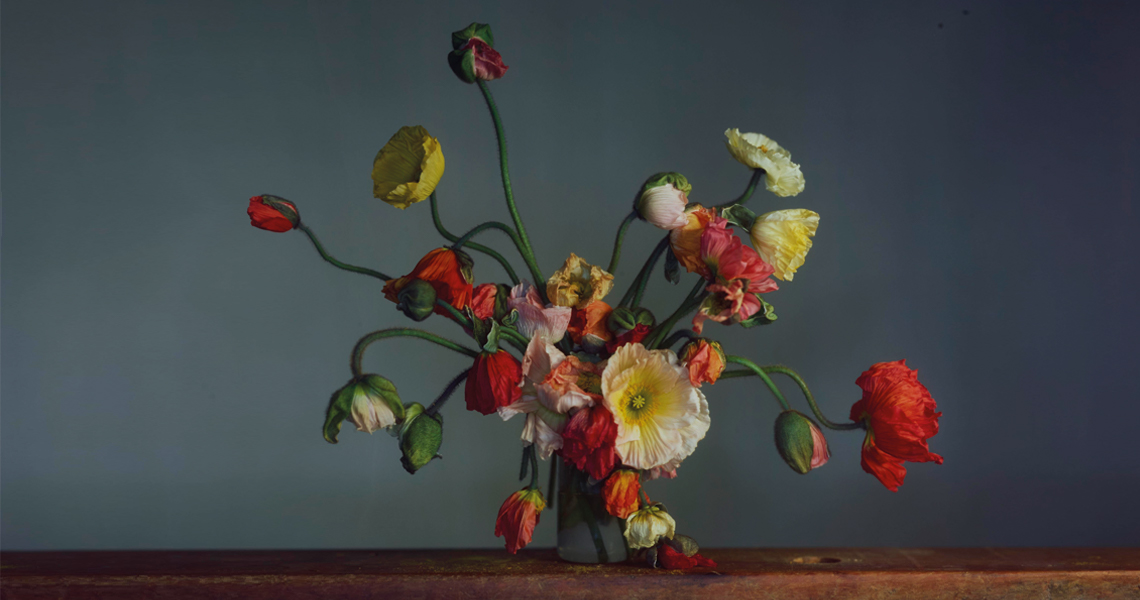Exuberant and tragic poppies: An interview with Richard Learoyd
Richard Learoyd's colour portraits make use of the oldest photographic processes - the camera obscura.
Using a walk-in camera, the size of a small room, Learoyd is able to expose his images directly onto large sheets of photographic paper, which are pinned to the wall inside this giant ‘camera room’. By removing himself from the room, he uses the process to create unprecedentedly authentic portraits, which walk a line between classicism and discomposure.
Occupying this same space between artistic tradition and contemporary realism, Learoyd’s still-life photographs of poppies explore the curious forms exhibited by this particular plant at various stages of death, writhing and reaching as though performing for the camera.
We spoke to him about the fascinating process behind these works featured in Unearthed: Photography's Roots.
What led you towards the camera obscura process?
Well, I had a very traditional British art education where I did a two year arts foundation course and then a three year degree course specialising in Photography at Glasgow school of art. During my time at Glasgow school of art I became interested in making larger scale photographs than was the norm at the time in the early 1990’s.
I started using the camera obscura technique as a quick way to make large images, making contact prints from paper negatives sped up the image making process. I would contact print the paper negatives whilst still wet and this gave a real sense of immediacy in the work. There is something about making photographs at scale that is different to a more traditional enlargement process.
It requires less imagination or pre-visualisation, it is simply more immediate.
The works featured in Unearthed show poppies at various stages of decay, but their arrangements often suggest a kind of animation, reaching out in different directions, as if they are still alive. Your portraits too, show people in stasis, which make them appear at times almost doll-like. What is it about this uncertainty between living and inanimate objects that interests you?
So what you’re describing this question are the innate property of photography. Photography can communicate stillness or movement and is good at both. I think that working with large still cameras forces me to deal with both these ideas. The pictures of poppies in the exhibition reflect my interest in the art genre. I think essentially these picture are very simple still-lives. There is something inherently transient in the poppy flower that encapsulates the nature of life as an existence. They are both live and dead. They are both growing and decaying which on a very simplistic level reflects a part of the human condition. They are both exuberant and tragic.
There’s something theatrical in the way your photos are composed - I’ve heard that you sometimes buy outfits for models to wear, and that each photo is intended to have an internal narrative - do you prepare for each composition with one in mind, or is it more experimental?
I find it interesting that people describe the work as painterly when in essence they could not be more photographic. This must be because my pictures are very composed. There are very few happy accidents. The experience of being a model in one of my pictures is not a terribly animated experience, it requires composure and stillness. It’s true that I do buy clothes and props for photographs mainly to obscure direct reference to a specific time.
I read that the company which produces your photographic paper has stopped making it - how does that affect your artistic plans for the future?
The material that I use to make colour photographs no longer exists and is no longer a viable commercial material. I am using stocks of this material and associated chemistry and when this is exhausted, I will seek new ways of making pictures. I am already using different materials and different ways to make photographs but there is something very special about a direct positive material.
It would be fair to say that there is a certain muted colour palette to the majority of your work. Your pictures of flowers are somewhat of a departure from this. Can you tell us a bit about your relationship with colour and how you feel its use, or emittance, influences the way your pictures are understood?
I work two simple rules as regards colour in my artwork. Colour creates contrast and colour promotes an emotional response. I use these two ideas to create my photographs. I often emphasis red colours as a way to draw the attention of the eye following nature.
Image credit: Richard Learoyd, Poppies, 2019 © the Artist. Image courtesy of Michael Hoppen Gallery.


